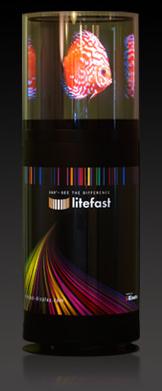OLED – New Screen Technology for Digital Signage
Posted by: Richard Williams | Posted on: | 0 Comments
It may only seem like yesterday but modern flat panel TV devices like LCDs and plasmas have been with us for well over a decade now. As such, we have seen them get bigger, flatter, wider and cheaper. The consequence has been that these digital screens are not just to be found in people’s front rooms but are now a common sight in shopping malls and transport hubs as digital signage and along the high street as outdoor digital signage.
Now, after years of research and development, another from of television displays is beginning to emerge. OLED screen technology (Organic Light Emitting Diodes) woks in a similar way to LCD technology but has many advantages to it.
An LCD television uses a layer containing liquid crystals which, when a current is passed through can create an image. A backlight on the LCD then provides the brightness so the image can be viewed.
With OLED screens a film of organic compounds covers each light emitting diode (LED). As these tiny light sources create the brightness required there is no need for a backlight and this has several advantages over LCD and plasma technology.
Firstly, OLED screens can generate a higher contrast ratio than an LCD TV creating better quality and more visible imaging. This would have great advantages for digital signage as the screens will become more readable and noticeable.
Secondly, as there is no need for a backlight system, OLED TV screens can be a lot thinner. The first OLED TV to arrive on the marketplace, for example, the Sony XEL-1, is only 3mm thick (1/8 of a an inch).

Digital Signage may go rotund – picture www.litefast-display.com
Finally, another advantage that could be extremely advantageous for digital signage screens is the ability of OLED to curve. Cylindrical and curved screens are now a possibility so we could soon be seeing digital signage equivalents of the rotund advertising kiosks (Morris columns).
There are of course, some disadvantages of this new technology, especially in implementing it into digital signage. As a new technology OLED’s are currently far too expensive to consider for digital signage at the moment and they are also size restricted with 20” being the largest OLED screen so far produced.
There are, as yet, no rugged solutions either, so any outdoor digital signage OLED screen will need the protection from a digital signage enclosure, and as yet, no manufacturers produce OLED enclosures … but watch this space.
Post shortlink:
Popular Products
LCD Enclosure
Need armor for your LCD/LED screen(s)? Outdoors or inside the versatile LCD enclosure protects against thieves, vandals & the weather. Installation idea: NFL stadiums.
Outdoor Digital Signage
Exclusive 46” outdoor screen protection. Dubbed the ‘Totem’, due to its distinct design, it repels damage threats, but attracts audiences. Installation idea: Drive-thru restaurants.
Portrait Flat Panel Enclosure
Safeguard your eye-level advertising display screen(s), indoors or outdoors. Completely customizable, add exciting features like touch screen technology. Installation idea: Restaurant frontages.
Indoor Digital Signage
Popular purchase for retail outlets! Great for ‘point of sale’ persuasion, boost your brand with static & motion advertising from a single unit! Installation idea: Mall of America.




